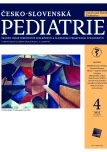The clinical phenotype and genetic diagnosis of a rare cutis laxa syndrome in a newborn with multiple anomalies
Authors:
Lenhartová Nina 1; Kršiaková Jana 1; Maťašová Katarína 2; Zibolen Mirko 2
Authors‘ workplace:
Oddelenie lekárskej genetiky, Univerzitná nemocnica Martin
1; Neonatologická klinika JLF UK a Univerzitná nemocnica Martin
2
Published in:
Čes-slov Pediat 2022; 77 (4): 226-231.
Category:
Case Report
doi:
https://doi.org/10.55095/CSPediatrie2022/037
Overview
De Barsy syndrome, also known as cutis laxa type III (ARCL3), is a rare genetic syndrome with autosomal recessive inheritance pattern, characterised by dysmorphic facial features, progeroid appearance, stretchy wrinkly skin, prenatal and postnatal growth retardation and intellectual disability, along with eye anomalies, atethoid movements and hyperreflexia. With many of its symptoms manifesting at birth, it should be considered when a clinical geneticist is confronted with progeroid appearance in a neonate. The diagnostic algorithm includes assessment of the clinical phenotype as the child develops, testing for micro- and submicroscopic chromosomal aberrations and specific DNA analysis of genes selected based on clinical phenotype and the attending clinical geneticist’s experience. In this report, we present a case of a newborn with multiple anomalies and progeroid appearance, along with an overview of their clinical phenotype and describing the diagnostic process.
Keywords:
cutis laxa – de Barsy syndrme – neonatal progeroid syndrome – PYCR1
Sources
1. de Barsy AM, Moens E, Dierckx L. Dwarfism, oligophrenia and degeneration of the elastic tissue in skin and cornea. A new syndrome?. Helv Paediatr Acta 1968; 23(3): 305–313.
2. Kunze J, Majewski F, Montgomery P, Hockey A, Karkut I, Riebel T. De Barsy syndrome-an autosomal recessive, progeroid syndrome. Eur J Pediatr 1985; 144(4): 348–354. doi: 10.1007/BF00441776
3. Reversade B, Escande-Beillard N, Dimopoulou A, et al. Mutations in PYCR 1 cause cutis laxa with progeroid features. Nat Genet 2009; 41(9): 1016–1021. doi: 10.1038/ng.413
4. Beyens A, Boel A, Symoens S, Callewaert B. Cutis laxa: A comprehensive overview of clinical characteristics and pathophysiology. Clin Genet 2021; 99(1): 53–66. doi: 10.1111/cge.13865
5. Seemanová E. Syndróm Debré cutis laxa. Čes-slov Pediat 2003; (1): 25–28.
6. Rosipal Š, Rosipalová D, Suchá K. Wiedemannov-Rautenstrachov syndróm s vrodenou chybou srdca. Čes-slov Pediat 2002; (5): 252–254.
7. Thomas J, Ragavi BS, Raneesha PK, et al. Hallermann-Streiff syndrome. Indian J Dermatol 2013; 58: 383–4.
8. De Ingeniis J, Ratnikov B, Richardson AD, et al. Functional specialization in proline biosynthesis of melanoma. PLoS One 2012; 7(9): e45190. doi: 10.1371/journal.pone.0045190
9. Albaugh VL, Mukherjee K, Barbul A. Proline precursors and collagen synthesis: biochemical challenges of nutrient supplementation and wound healing. J Nutr 2017; 147(11): 2011–2017. doi: 10.3945/jn.117.256404
10. Wu G, Bazer FW, Burghardt RC, et al. Proline and hydroxyproline metabolism: implications for animal and human nutrition. Amino Acids 2011; 40(4): 1053–1063. doi: 10.1007/s00726–010–0715–z
11. Lin DS, Chang JH, Liu HL, et al. Compound heterozygous mutations in PYCR 1 further expand the phenotypic spectrum of De Barsy syndrome. Am J Med Genet A 2011; 155A(12): 3095–3099. doi: 10.1002/ajmg.a.34326
12. Kivuva EC, Parker MJ, Cohen MC, et al. De Barsy syndrome: a review of the phenotype. Clin Dysmorphol 2008; 17(2): 99–107. doi: 10.1097/ MCD.0b013e3282f4a964
13. Aldave AJ, Eagle RC Jr, Streeten BW, et al. Congenital corneal opacification in De Barsy syndrome. Arch Ophthalmol 2001; 119(2): 285–288.
14. Dutta A, Ghosh SK, Ghosh A, Roy S. A 5-year journey with cutis laxa in an Indian child: the De Barsy syndrome revisited. Indian J Dermatol 2016; 61(1): 81–84. doi: 10.4103/0019–5154.174031
15. Gardeitchik T, Mohamed M, Fischer B, et al. Clinical and biochemical features guiding the diagnostics in neurometabolic cutis laxa. Eur J Hum Genet 2014; 22(7): 888–895. doi: 10.1038/ejhg.2013.154
16. Zampatti S, Castori M, Fischer B, et al. De Barsy Syndrome: a genetically heterogeneous autosomal recessive cutis laxa syndrome related to P5CS and PYCR 1 dysfunction. Am J Med Genet A 2012; 158A(4): 927–931. doi: 10.1002/ajmg.a.35231
Labels
Neonatology Paediatrics General practitioner for children and adolescentsArticle was published in
Czech-Slovak Pediatrics

2022 Issue 4
Most read in this issue
- Sepsis in children
- Differential diagnosis of microscopic hematuria
- Dystrophinopathies
- Hyperthermia, its causes and risks from the pathophysiologist’s perspective
